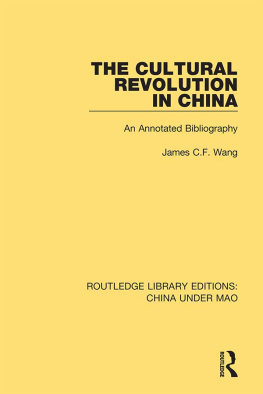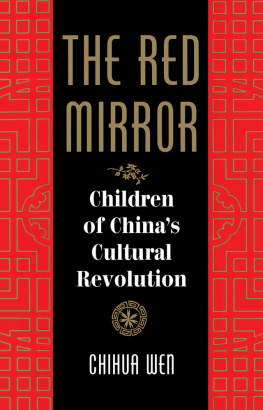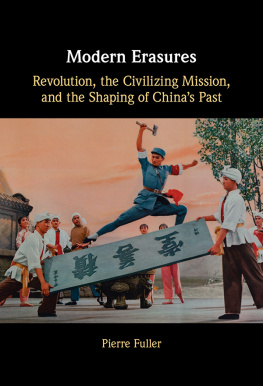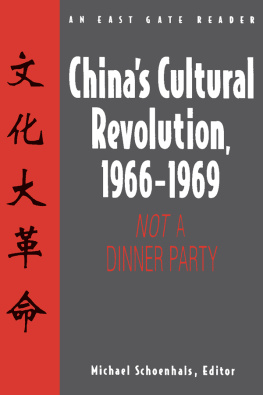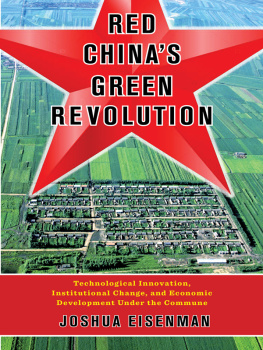Thank you for buying this ebook, published by NYU Press.
Sign up for our e-newsletters to receive information about forthcoming books, special discounts, and more!
Sign Up!
About NYU Press
A publisher of original scholarship since its founding in 1916, New York University Press Produces more than 100 new books each year, with a backlist of 3,000 titles in print. Working across the humanities and social sciences, NYU Press has award-winning lists in sociology, law, cultural and American studies, religion, American history, anthropology, politics, criminology, media and communication, literary studies, and psychology.
The Unknown Cultural Revolution
THE UNKNOWN CULTURAL REVOLUTION
Life and Change in a Chinese Village
Dongping Han

Copyright 2008 by Monthly Review Press
All rights reserved
Originally published as The Unknown Cultural Revolution: Educational Reforms and Their Impact on Chinas Rural Development by Garland Publishing, Inc.
Library of Congress Cataloging-in-Publication Data
Han, Dongping.
The unknown cultural revolution : educational reforms and their impact on Chinas rural development.
p. cm.
Author: Dongping Han.
Originally published: Garland Pub. : New York, 2008.
ISBN 978-1-58367-180-1 (pbk.)
1. Rural development--China. 2. Education, Rural--China. 3. Educational change--China. 4. Rural children--Education--China. 5. China--Social conditions. 6. China--Politics and government. 7. China--History--Cultural Revolution, 1966-1976. I. Title.
HN740.Z9C6377 2008
307.14120951--dc22
2008050563
Monthly Review Press
146 West 29th Street, Suite 6W
New York, NY 10001
5 4 3 2 1
CONTENTS
by Fred Magdoff
TABLES
CHAPTER 2
CHAPTER 3
CHAPTER 5
CHAPTER 6
PREFACE
The experiences of the attempts to build socialism in the Soviet Union and China have made it clear that the class struggle continues even after power has been seized in a revolution. They also teach that path to socialism is a long one along an uncertain route. As Mao Zedong wrote:
Marxism-Leninism and the practice of the Soviet Union, China and other socialist countries all teach us that socialist society covers a very, very long historical stage. Throughout this stage, the class struggle between the bourgeoisie and the proletariat goes on and the question of who will win between the roads of capitalism and socialism remains, as does the danger of restoration of capitalism. (Mao Zedong, On Khrushchevs Phony Communism and Its Historical Lessons for the World: Comment on the Open Letter of the Central Committee of the CPSU, 1964)
Maos purpose for initiating the Cultural Revolution (19661976) was to mobilize and engage millions and millions from all sectors of societyworkers and peasants as well as students and intellectualsin a struggle against the forces within the Party that favored the restoration of capitalism. Among most intellectuals in China and the United States, the Cultural Revolution has been viewed as an era of inhumane chaos. And it is true that the Cultural Revolution was chaotic, with various Red Guard factions (some were even sham Red Guards, possibly organized by those under attack to confuse the masses) and many instances of exaggerated and inhumane treatment of people, including some killings.
Most of the writings about the Cultural Revolution have emphasized the problems, especially of intellectuals. However, in the rural areas of the country this period is still viewed in a much more positive lightan era when much infrastructure was built, agriculture advanced markedly, and attention was paid to problems of the people living in the countryside. Thus the lives of the rural populationin other words, the great mass of the peopleduring this period has received little attention.
Few people are aware of the visit to China in the summer of 1974, during the Cultural Revolution, by a delegation of U.S. agronomists. They traveled widely and were amazed by what they observed, as described in an article in the New York Times (September 24, 1974). The delegation was composed of ten scientists who were experienced crop observers with wide experience in Asia. As Nobel Prize winner Norman Borlaug put it, You had to look hard to find a bad field. Everything was green and nice everywhere we traveled. I felt the progress had been much more remarkable than what I expected. The head of the delegation, Sterling Wortman, a vice president of the Rockefeller Foundation described the rice crop as really first rate. There was just field after field that was as good as anything you can see. They were also impressed with the increased skill levels of the farmers on the communes. Wortman said Theyre all being brought up to the level of skills of the best people. They all share the available inputs. A detailed description of their observations on agriculture in China was published in prestigious journal Science in 1975 (vol. 188:549-555) by Dr. Sprague. Much of the progress in Chinas agriculture after the Cultural Revolution was made possible by the advances during that period. Even the increase in fertilizer use that occurred in the late 1970s and early 1980s was made possible by factories that were contracted for by China in 1973.
During prolonged discussions in the 1990s with a former village leader from another province during the Cultural Revolution, I heard a remarkably similar description of events to the one described in this book. The importance of this work by Han Dongping is that it brings into focus the lives of villagers during a dynamic period of great positive change in the countryside. This is a very significant worka counterweight to the conventional writings about the Cultural Revolution.
Fred Magdoff
University of Vermont
Burlington, Vermont
Preface and Acknowledgments
I grew up in a Chinese village during the Cultural Revolution. In 1966, when the Cultural Revolution started, there were many illiterate people in my village. My mother never went to school and my father had learned how to read and write simple words by attending night school in his factory. My elder sister had only three years of primary school education. In my neighborhood, many children who were a few years older than I either never went to school or dropped out after one or two years of primary school. Not many people finished primary school, and only a few went as far as junior high school in my village.
During the educational reforms of the Cultural Revolution, my village set up its own primary school, and hired its own teachers. Every child in the village could go to the village school free of charge. My village also set up a junior middle school with six other villages. Every child could go to this joint village middle school free of charge and without passing any examinations. The commune that included my village set up two high schools. About 70 percent of school-age children in the commune went to these high schools free of charge and without passing any screening tests. All my siblings except my elder sister, who was four years older than I, were able to finish high school. At the time we did not feel this was extraordinary at all. Most people took going to high school for granted. Upon graduation from high school, I went back to my village like everybody else, and worked on the collective farm for one year and then worked in the village factory for three and one half more years before going to college in the spring of 1978.
Next page

